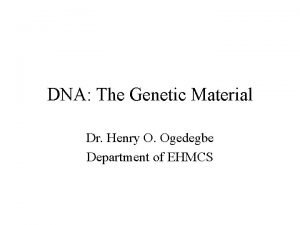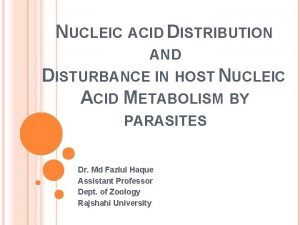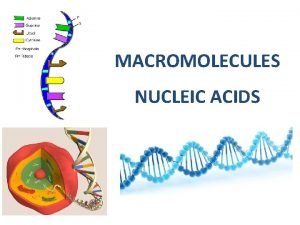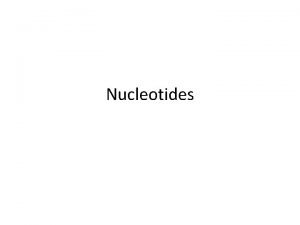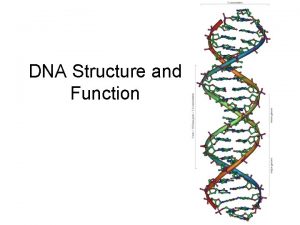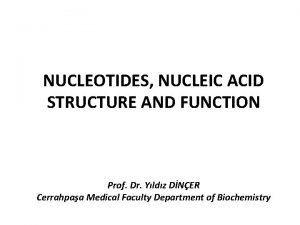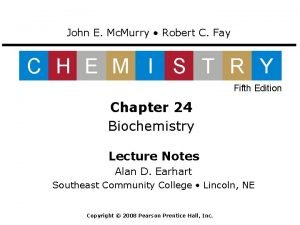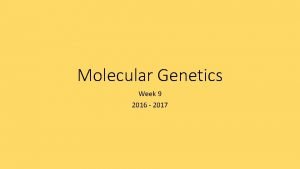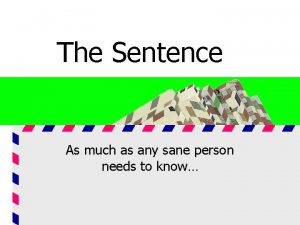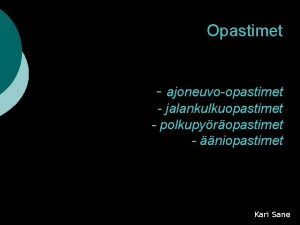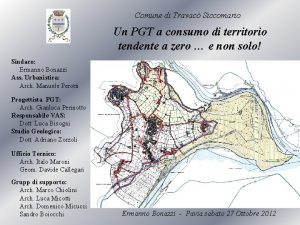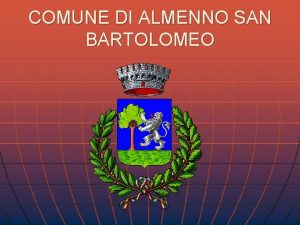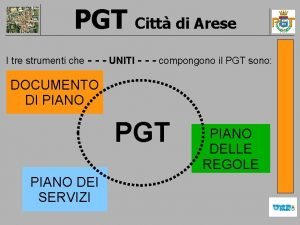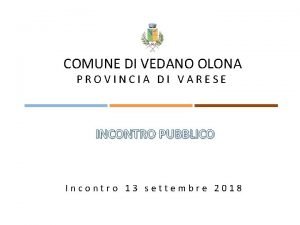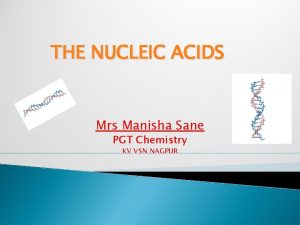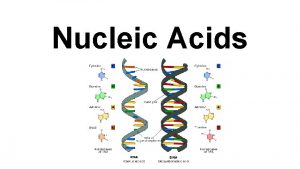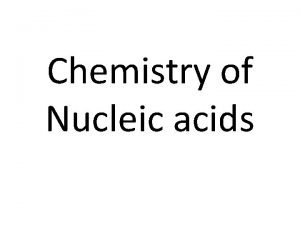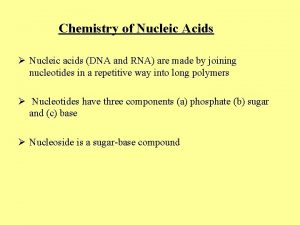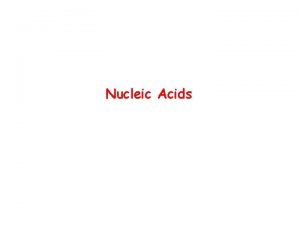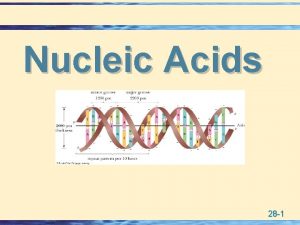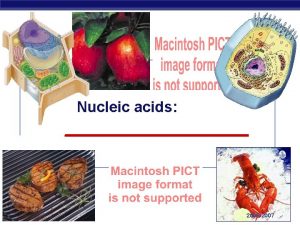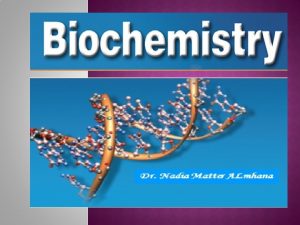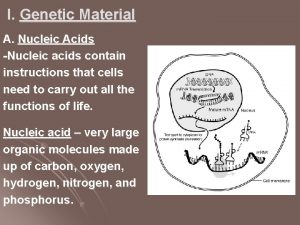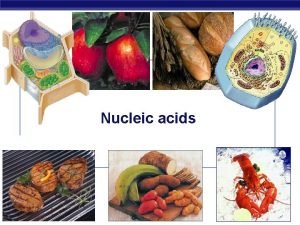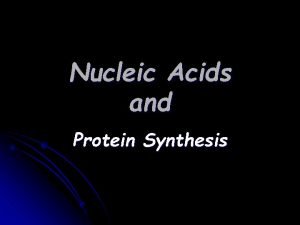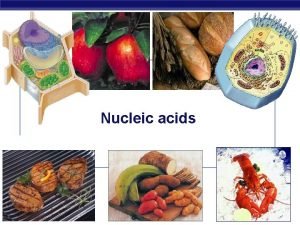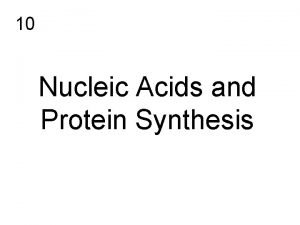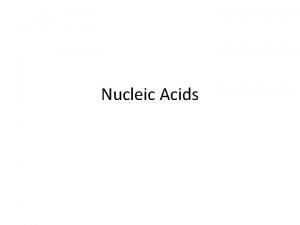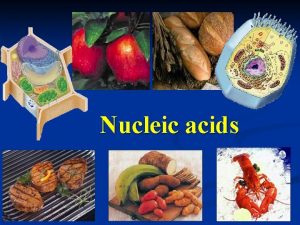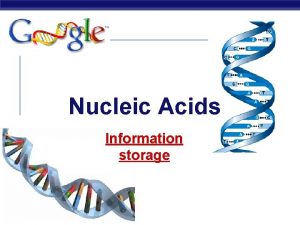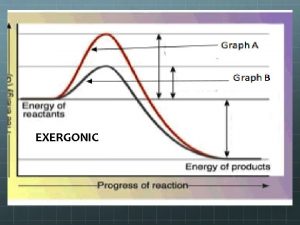THE NUCLEIC ACIDS Mrs Manisha Sane PGT Chemistry




























- Slides: 28

THE NUCLEIC ACIDS Mrs Manisha Sane PGT Chemistry KV VSN NAGPUR

Two types of nucleic acid are found Deoxyribonucleic Ribonucleic acid (DNA) acid (RNA)

The distribution of nucleic acids in the eukaryotic cell DNA is found in the nucleus with small amounts in mitochondria and chloroplasts RNA is found throughout the cell

NUCLEIC ACID STRUCTURE Nucleic Their acids are polynucleotides building blocks are nucleotides

NUCLEOTIDE STRUCTURE PHOSPHATE BASE SUGAR Ribose or Deoxyribose PURINES PYRIMIDINES Adenine (A) Cytocine (C) Guanine(G) Thymine (T) Uracil (U) NUCLEOTIDE

Ribose is a pentose sugar C 5 O C 1 C 4 C 3 C 2

Spot the difference DEOXYRIBOSE CH 2 OH O C H H H C OH OH CH 2 OH C C H H OH O C H H C C C OH OH H H

Nitrogenous Bases Pyrimidines Purines Adenine Guanine Thymine In DNA Cytosine Uracil In RNA

Purines & Pyrimidines in DNA Adenine Guanine Thymine Cytosine

Watson & Crick Base pairing

Nucleosides & Nucleotides

THE SUGAR-PHOSPHATE BACKBONE The nucleotides are all orientated in the same direction The phosphate group joins the 3 rd Carbon of one sugar to the 5 th Carbon of the next in line. P P P

P G ADDING IN THE BASES P C The bases are attached to the 1 st Carbon Their order is important It determines the genetic information of the molecule P C P A P T

Hydrogen bonds P DNA IS MADE OF TWO STRANDS OF POLYNUCLEOTIDE G C P P C G A T T A P P P T A P

DNA IS MADE OF TWO STRANDS OF POLYNUCLEOTIDE The sister strands of the DNA molecule run in opposite directions (antiparallel) They are joined by the bases Each base is paired with a specific partner: A is always paired with T G is always paired with C Purine with Pyrimidine Thus the sister strands are complementary but not identical The bases are joined by hydrogen bonds, individually weak but collectively strong.

The Double Helix (1953) www. chem. ucsb. edu/. . . /images/Watson. Crick. jpg

Functions Of DNA Replication Transcription Translation Protein Synthesis Function Of RNA It controls protein synthesis.

Biological Functions of Nucleic Acids: • DNA is exclusively responsible for maintaining the identity of different species of organisms over millions of years. • DNA is the chemical basis of heredity and may be regarded as the reserve of genetic information. • A DNA molecule is capable of self duplication during cell division and identical DNA strands are transferred to daughter cells. • Another important function of nucleic acids is the protein synthesis in the cell. • Actually, the proteins are synthesised by various RNA molecules in the cell but the message for the synthesis of a particular protein is present in DNA.

SEMI CONSERVATIVE DNA REPLICATION

Replication Of DNA

Translation is the second process of protein biosynthesis (part of the overall process of gene expression). Translation occurs in the cytoplasm where the ribosomes are located. Ribosomes are made of a small and large subunit which surrounds the m. RNA. In translation, messenger RNA (m. RNA) is decoded to produce a specific polypeptide according to the rules specified by the genetic code. This is the process that converts an m. RNA sequence into a chain of amino acids that form a protein

Protein Synthesis

IMPORTANT TERMS Codon---The Triplet of nucleotide coding a Gene— Sequence of the nucleotides in DNA Genetic code-- the relation between the particular amino acid. Total 64, 61 for inner amino acids and 3 for terminal amino acids. coding a particular protein. nucleotide triplet and the amino acid. Genetic code is Degenerate and more then one codons may code for same amino acids.

The Genetic Code The language of RNA to the language of protein: The genetic code is a triplet code in which three nucleotides in RNA specify one amino acid in protein. RNA consists of four "letters": A, U, G, and C. Protein consists of 20 "letters": the amino acids. Triplet code AUG start codon Encodes methionine UAA, UAG, UGA stop codons



DNA FINGERPRINTING

 Functions of nucleic acid
Functions of nucleic acid Nucleic acid made up of
Nucleic acid made up of Nucleic acid
Nucleic acid The building block of nucleic acid.
The building block of nucleic acid. Pentose sugar in rna
Pentose sugar in rna Alloburinol
Alloburinol Foods rich in nucleic acids
Foods rich in nucleic acids Polymer structure of nucleic acids
Polymer structure of nucleic acids Function of nucleotides
Function of nucleotides Composition of nucleic acids
Composition of nucleic acids Nucleic acids
Nucleic acids Function of nucleic acids
Function of nucleic acids Deoxyribose nucleotide
Deoxyribose nucleotide Nucleic acids concept map
Nucleic acids concept map Any sane person
Any sane person Maureen hanlon
Maureen hanlon Yogesh sane
Yogesh sane Liikennevalojen pääopastin
Liikennevalojen pääopastin Pgt travacò siccomario
Pgt travacò siccomario Istituto comprensivo almenno san bartolomeo
Istituto comprensivo almenno san bartolomeo Pgt martinengo
Pgt martinengo Pgt mandello del lario
Pgt mandello del lario Pgt arese
Pgt arese Pgt vedano olona
Pgt vedano olona Cehl:morv::wybf
Cehl:morv::wybf Dr manisha mathur
Dr manisha mathur Modified fdi system
Modified fdi system Manisha dasgupta
Manisha dasgupta Manisha gunasekera
Manisha gunasekera
